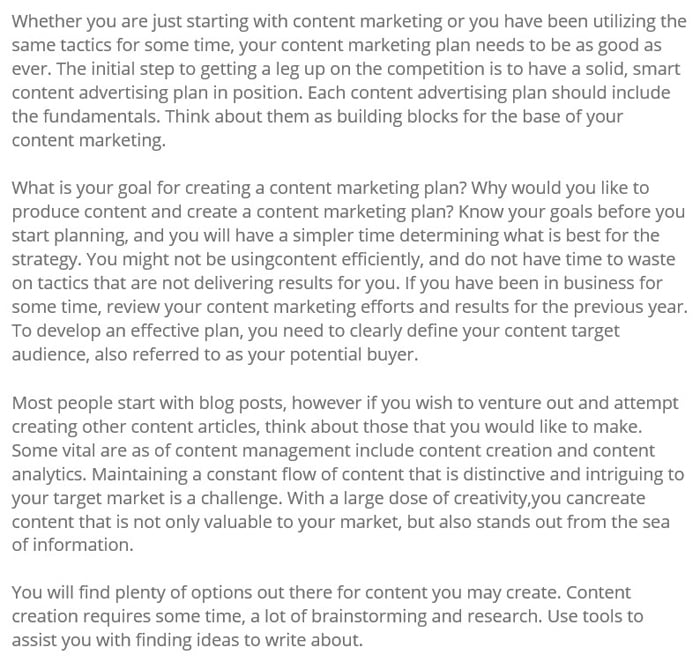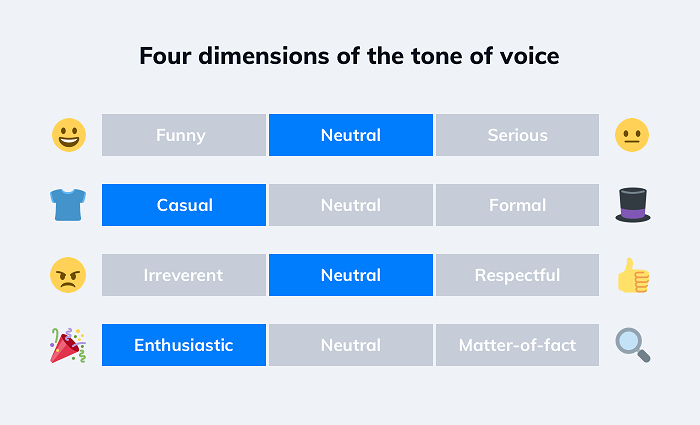Humanize AI-generated advertising and marketing content material
While future writers are unlikely to be robots, artificial intelligence (AI) has made it possible for hybrid robot-human systems to create and manipulate content.
However, you don't have to worry about your job as a blogger or a writer.
AI-generated marketing content still lacks the human touch.
We still need writers and marketers to edit and revise content to fit our desired context and avoid misunderstandings in the online world. Instead, using AI can speed up the writing process and allow marketers to produce more content for the sales funnel.
How do you humanize AI content? Here's what you need to know:
What is AI Generated Content?
AI generated content, as the name suggests, simply means content written by AI.
Most AI technologies can perform activities that would normally require human thinking, intelligence, learning, or decision making.
Regarding the content marketing process, AI is able to create a written narrative through Natural Language Generation (NLG). This function makes it possible to write business reports, predict consumer behavior, plan content and offer personalized product recommendations.
We bet you used AI-assisted marketing tools without realizing it.
Additionally, you've probably read content written with the help of AI as well.
The UK Press Association has used AI to write around 30,000 local news items a month. The technology company OpenAI, co-founded by Elon Musk, has launched the “GPT-3” AI tool that can write like a human. Researchers have reportedly used it to write stories, share philosophical knowledge, and answer medical queries.
Interestingly, Econsultancy reports that 18 percent of North America-based marketers use AI to create content. 23 percent now use it for creative and design work.
These statistics show that AI generated content has a place in marketing.
AI subsets used for content
AI can create content through its subset, known as "content intelligence".
Content intelligence leverages AI capabilities to help marketers create compelling posts and get research-based advice on their marketing strategies.
This is made possible through a simple three step process:
- Data collection: AI collects data from CRM, surveys, social media results, visitor behavior of websites and other relevant sources of information.
- Analysis: In this phase, AI analyzes and interprets the data to find trends and patterns.
- Insights and Recommendations: AI can develop insights to change your content and make it more effective and valuable to your target audience. It can also predict trends so you can increase your ROI on content over the long term.
In summary, content intelligence enables marketers to interpret the data to make research-based decisions and improve their content marketing results.
Why is it important to humanize AI-generated content?
In recent years we have seen that AI can automate many processes, but still cannot operate unattended. Even if the AI can write thousands of words, the message still needs to be humanized in order to have a lasting impact on its readers.
Let's take a look at some of the benefits of AI that you should consider.
1. Humanize content to encourage personalization
People don't want marketing messages that seem robotic and repetitive.
We see tons of marketing messages every day, so AI-generated content alone doesn't make you stand out in the online world.
An interesting study by Adobe found that 67 percent of respondents believe it is critical for businesses to change their content based on context. If it's not done right, 42 percent are annoyed because the content is not personalized.
While AI can automate the writing process, it still requires humanizing the output so you can communicate authentically and sincerely with your audience.
2. AI is still not perfect
AI can follow basic grammatical structure, but its results are not always perfect.
For example, The Guardian hired the GPT-3 AI tool to write their content.
Here is a paragraph of the results:

Some of the editions were concise and cleverly written. However, AI technologies can be sprawling, create nonsensical paragraphs, and go way beyond the specified number of words.
Though AI has formidable writing skills, its dense articles mimick what you'd find on Wikipedia. Spam text could find its way into the draft or contain out of context words or derogatory remarks.
Even if paragraphs could be stringed, editors would have to select the information that would end up in the final draft.
The final result? Marketers have yet to humanize the design and edit the content for human consumption.
3. Humanize content to maximize data
Of course, AI can quickly analyze the data and figure out what works and what doesn't.
However, it is still unable to truly understand and empathize with readers.
It can't work on its own to create compelling scripts for your ads or video campaigns. You still have to edit the outputs to match your branding voice, frame, and narrative.
Even if you have the necessary data, human input is required to make sure the content gets through to your audience.
Instead of doing the AI on your own, add a human touch to get the best of both worlds.
7 tips for humanizing AI-generated content
AI can bring many benefits to your content marketing funnel. So how can you humanize the output to create effective marketing content? Find out how to do it.
1. Humanize your strategy
AI tools can do keyword research, suggest trending topics, and suggest blog post ideas based on your competitors' top performing content.
Despite the long list of article ideas, you still have to humanize your content strategy.
For example, suppose you plan to assign an article to "X Tips for YouTube Marketing" at the suggestion of your AI.
For the best results, discuss this with your team to find little-known advanced tips. After all, your AI tool can choose generic strategies that everyone is familiar with.
Some articles can be a sensitive subject, so careful drafting and prior discussion is required. In other cases, you may need input from your customer-facing reps (e.g. sales reps) to humanize the output so that it feels relevant to your target audience.
2. Think of AI-generated content as a first draft
Starting from scratch is a major challenge for many writers.
Finding the motivation you need to write a 1000 word article when you are at zero can be difficult.
The good news is that AI-generated content can act as an "ugly first draft".
The Washington Post published 850 articles with the help of a native AI robot called the Heliograf, which can write short reports and posts. The first draft helps writers overcome their slump and get into the groove by simply modifying AI-generated content.
Tools like Articoolo can also write AI-generated content. Authors just need to insert the topic and choose their preference.
For example, suppose you are writing a short article about a "content marketing plan".
Here is an example of what this might look like:

Safe to say it's not perfect. However, a little editing can help you add a few introductory paragraphs or create an outline.
As you write the article, you can use AI to draft more specific sections by entering more specific keywords like "benefits of content marketing" or "creating a content marketing plan".
3. Stick to the voice of your brand
Brand voice refers to the emotions and personality that your brand wants to inspire in your audience.
Should you be fun or approachable? If you want to look friendlier and more reliable, consider using a casual tone or a bit of slang. If you want to exude a luxurious feel, stick to a formal tone as well.
Here is a brand language card that you can use to find out the characteristics of your brand:

How does a brand voice fit into marketing content generated by AI? AI-generated content may be grammatically perfect, but it appears robotic.
By keeping an eye on your brand voice, you can make the AI output seem more personal and real.
4. Look at the context
One of the limitations of AI is that the context cannot yet be considered.
It can create generic text for a general audience, but not for a specific target consumer.
Because of this, it is important to remember the personas of the buyer. Before writing or editing any text generated by AI, answer the following questions:
- Who are my audience readers?
- Why is my content relevant to you?
- How do I want to communicate with you?
If you work with a large number of writers or editors, you may want to create article outlines. Ideally, this should include notes for each section of the content or details about your target audience.
In this way, when an editor revises the content generated by the AI, it ensures that it matches the desired context.
5. Make it short
As shown in the previous example, marketing content generated by AI can look like a long paragraph with hundreds of words.
Of course, readers don't read long lines of text.
To humanize your content, break a paragraph into two to three lines of text (60 to 90 characters). Make it chatty by asking questions every now and then to mimic human conversations. You can occasionally keep sentences short or on a single line to make a point.
6. Personalize content at every stage of the sales process
Eighty percent of shoppers are more likely to buy from brands that offer personalized experiences.
To humanize your sales and marketing funnel, you need to create personalized experiences. While this can take time and effort, AI technologies can accelerate and automate the process.
With data-based personalization, marketers can enable consumers to display information that is directly relevant to them based on their behavior and interests.
Here are a few ways AI can humanize your sales funnel:
- Deliver automated emails with personalized product recommendations or abandoned cart reminders.
- Use chatbots to answer customer queries or direct customers to the appropriate FAQ section so they can solve the problem without waiting for customer support.
- Show pop-ups or send downloadable resources from previously viewed content.
Again, AI can identify data and automate the process, but you need human input to connect the dots. Your sales teams may occasionally need to change the chatbot scripts based on previous customer interactions to drive engagement.
For email marketers, you may want to review the design and content of the top performing emails. Run A / B tests to find out the most compelling CTAs, ideal text, or image placement.
With this process, you can humanize AI-generated content and make it relevant to your customers.
7. Use a mix of tools
Just like humans, AI tools have specializations.
Some are good at writing while others are specifically designed to edit or perform plagiarism checks. Humanizing AI content involves finding the right tool for each step of the process.
Suppose you want to write a blog post. Here's a quick rundown of what the process might look like:
- Brainstorming Blog Topics (30 Minutes)
- Research (2 hours and 30 minutes)
- Writing (5 hours)
- Edit (1 hour)
- Publish (10 minutes)
Try to find tools that can help you at each stage to streamline the writing process. Here are a few to get you started:
- Atomic range:: to analyze current content and identify the topics that resonate with your audience
- Articoolo:: to immediately generate the first drafts of an article
- grammar:: to improve vocabulary, to check spelling, to check for plagiarism and to eliminate grammatical errors
- Hemingway:: to make your writing more chatty by highlighting difficult-to-read sentences and suggesting simpler alternative sentences
- Milling:: To reveal the questions searchers are asking to create SEO optimized content that dominates the SERPs
Conclusion
AI can speed up your content creation process, but it still requires human input.
To ensure that content generated by AI is correct and accurate, have it checked by an author or editor. Make it short and make sure it fits in with the intended context.
Think of your brand voice to humanize the content and add a bit of personality.
There are a variety of AI digital assistants that can optimize for SEO, write a draft, or edit the content. Once you are familiar with these next generation content writing tools, you can speed up and automate the writing process.
How will you humanize AI generated marketing content?

See How my agency can drive Firmly Traffic volumes on your website
- SEO – Unlock tons of SEO traffic. See real results.
- Content Marketing – Our team creates epic content that is shared, links accessed and visitors drawn.
- Paid media – effective paid strategies with a clear ROI.
Book a call
